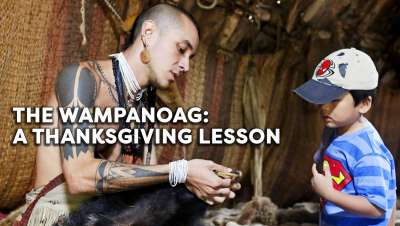Crazy Horse
"[Judith] St. George's portrait includes not only pertinent historical information about Crazy Horse's dealings with the U.S. military but fascinating details about his personal life as well... Thoroughly researched and filled with passion, the action-packed narrative communicates the author's admiration for her subject. Her attention to detail raises the book above the usual level of biography to forge a lasting image of an American hero and the people he loved." –Publishers Weekly (starred review)
Discussion and Comprehension Questions
1. What was promised to the Indians as a result of signing the Horse Creek Treaty of 1851?
2. What event was believed to have touched off the twenty year war between the Plains Indians and the U.S. Army?
3. How did the Oglala Sioux dress for battle?
4. What did the white soldiers do to avenge what they termed the Grattan Massacre?
5. Where does the word Sioux originate?
6. Name the Seven Council Fires of the Sioux Nation and tell where each settled.
7. To which of the Council Fires did Crazy Horse belong?
8. What was the significance for Sioux warriors of scalping their enemies?
9. What were Crazy Horse's views regarding ownership of land?
10. How did he receive the name Crazy Horse? How did the Sioux name their children?
To See with the Heart: The Life of Sitting Bull
"The result is a complete portrait of Sitting Bull as son, husband, father, friend, holy man, hunter, and war chief of the Sioux Nation. The author has thoroughly researched her subject... St. George's admiration for Sitting Bull comes across throughout this informative, well-documented, and valuable biography." – School Library Journal
Discussion and Comprehension Questions
1. What event took place at Birch Grove in 1851? What was the result?
2. What were the events that led to the Battle of Killdeer Mountain?
3. What were some important elements of Sioux life?
4. What was the importance of family?
5. What did the Sioux think of the way white people treated their children?
6. What were the roles of men and women in Sioux life?
7. How did the Sioux express their spirituality?
8. What was the importance of war in Sioux culture?
9. Describe the Sun Dance. Why did Sitting Bull undergo that ritual?
10.Why did Sitting Bull agree to leave Canada and surrender to the white man?
11. What promises were made? Were they kept?
12. What were Sitting Bull's opinions regarding ownership of land?
13. What was the Ghost Dance religion?
14. Why did so many Indian tribes believe in this religion?
15. How did white men perceive this religion?
16. How did the death of Sitting Bull affect the Sioux tribe?
17. How has the Sioux culture survived reservation life?
Sacagawea
"In a well-written and well-researched account, St. George humanizes her subject by revealing what she imagines Sacagawea's thoughts and emotions were during Lewis and Clark's 5,000-mile Journey of Discovery. Adventure lovers will find much to like in the book: attacking grizzlies, dangerous rapids, hostile Indians, and mysterious illnesses with unusual cures. But children will also learn details about an important historical event and get a glimpse of Native American life in the early 1800s." -Booklist
Discussion and Comprehension Questions
1. What was the Journey of Discovery? What was its purpose?
2. Why did President Jefferson feel it was important to explore the western United States?
3. How did Sacagawea meet her husband, Toussaint Charbonneau? What was his occupation?
4. What role did Shoshone women have within their tribe?
5. What were some of the Shoshone traits? Physically? Emotionally?
6. Why did Lewis and Clark want to hire Sacagawea and her husband? How would they benefit the expedition?
7. What were Lewis and Clark's strengths and weaknesses as leaders of the expedition?
8. What kinds of medical treatments did they use to heal the sick on the expedition?
9. What kind of relationship did Sacagawea have with Lewis, Clark, and the other members of the expedition?
10. What kind of relationship did the men have with Toussaint Charbonneau?
11. By what means did the group travel to the Pacific Ocean?
12. How did they navigate their route?
13. What kinds of obstacles did they encounter?
Crazy Horse
Time Line
Create a time line of the Sioux Wars, including events leading up to and after it. Discuss key participants of the war and have students prepare short biographies to read to the class as that historical person.
Research
Have students research the Sioux Wars with different groups focusing on specific segments of the wars to present to the entire class. While learning about the history of the wars, the students should also gain an understanding of the Sioux people. Learn about their families, language, diet, beliefs, and way of life. Examine how their lives changed as their land was taken over.
Tribal Fact Book
Have the students choose a Native American tribe and make a historical fact book outlining its history. Have them include information on how the tribe was affected by the white settlers, what effect the United States government had on the tribe, and what changes the government brought. Where does this tribe live today?
To See with the Heart: The Life of Sitting Bull
Heroes
Study a few great leaders in Native American history emphasizing some well-known and not-so-well-known facts about each person. Discuss what they stood for, how they became leaders. Describe their tribes and families. How were Indian leaders chosen? What made them good leaders?
Examining Different Cultures
Compare the lifestyles of the different Indian cultures in the United States (Eastern Forest Indians, Plains Indians, Northwest Coast Indians, California-Intermountain Indians, and Southwest Indians). Discuss their religions, dress, music, language, dance, food, and traditions.
Native American literature
Have the students learn more about Native American literature by bringing and reading in class a story, poem, or Native American writing. They should research the tribe from which the story came, the author of the story, and the significance of the story.
Sacagawea
Geography
Have students mark the progress, places, and events of the journey on a large map of the Northwest, which includes North Dakota, Montana, Idaho, Washington, and Oregon. Compare the earth's surface and other formations since the expedition.
Model
Build a three-dimensional model of the Northwest and mark the trail Lewis and Clark took on their expedition. Research certain points on their trail to share with the class and discuss the original and modern names for rivers and places. Make special markers for and a special map key explaining certain events and situations.
Keeping a Journal
Have students write journals from the perspective of a member of the journey. Have them describe their daily responsibilities, the weather, their food, the wildlife, the difficulties they overcame, the tribes they encountered, and how the expedition affected their lives.












